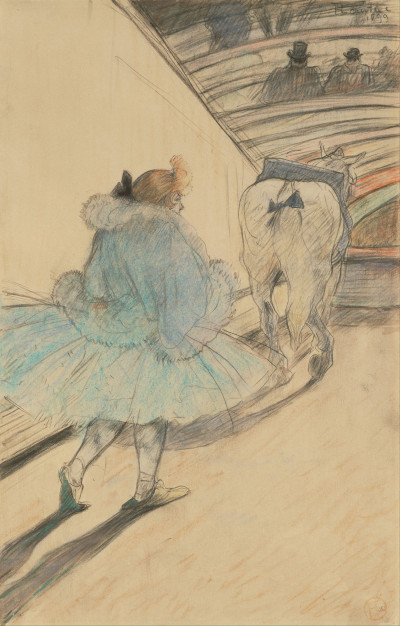At the Circus - Entering the Ring, originally known as Au cirque: Entrèe en piste, continues the artist's focus on circuses within his paintings and sketches from the late 19th century.
We find here a lady leading out a horse, as they enter the main section of the circus. In order to set the scene, the artist adds rows of seats at the back which curve around, along with a number of patrons. Toulouse-Lautrec was highly interested in the night life of Paris at that time, and tried to look deeper into these environments, capturing some of the less glamorous elements of this life. He would, for example, feature dancers resting in between cabaret shows, as they prepared themselves. In this case we find a attractively dressed woman appearing, ready to perform her latest act. The artist became friends with a number of these performers, which enabled him to offer sensitive depictions of their lives, and was welcomed into their personal space.
An important aspect to this work is that it was entirely from the artist's memory. He was sadly within a lunatic asylum at the time, and was working in an effort to prove his improved mental health. His behaviour has become erratic and so his submission to this institution was entirely reasonable at the time. Alcohol would, eventually, take his life in any case but drawings such as At the Circus - Entering the Ring helped to achieve his freedom for another fleeting moment. He was released after three months, and put it down to this series of drawings.
The J. Paul Getty Museum in the US own this particular piece, and list it as having been produced using black and coloured chalks. It is relatively small, at only 31cm in height by 20cm in width - this fairly standard size may suggest that it was originally from a sketchbook before being removed and sold separately. Toulouse-Lautrec was a highly skilled draughtsman whose contributions to this medium are sometimes forgotten amidst his more famous use of oils in classic artworks such as At the Moulin Rouge, Moulin Rouge: La Goulue and Divan Japonais. Much of his best work would then be printed as lithographs, allowing more people to buy copies of his work, thus spreading his name deeper into society. Visitors to the Getty Museum should check first before visiting if there is a specific item that they would like to view, as some can be loaned out from time to time, in order to allow as many to see their large collection as possible.




